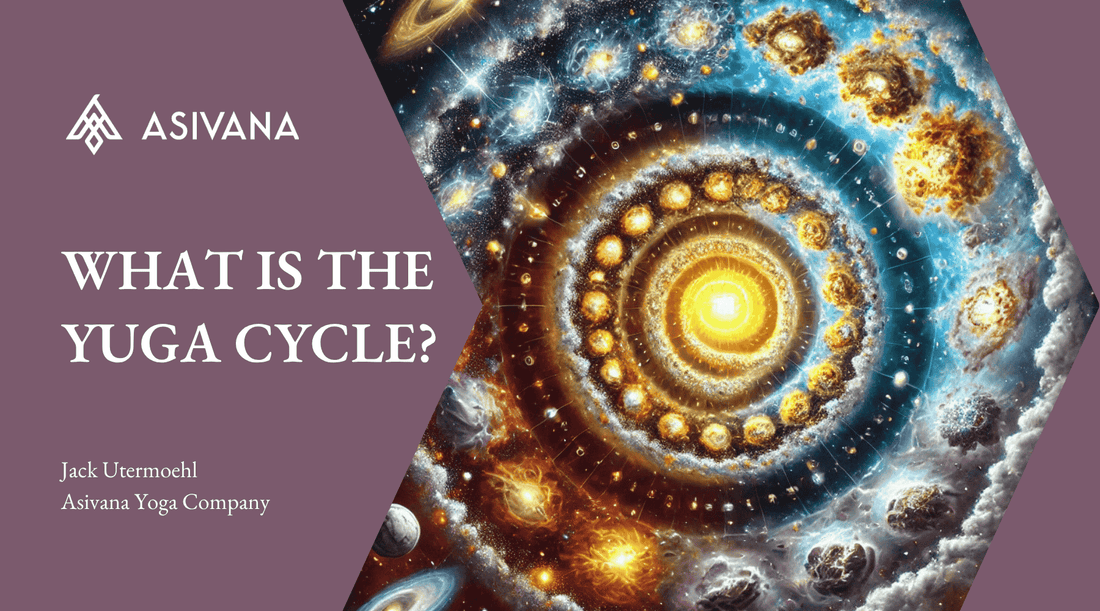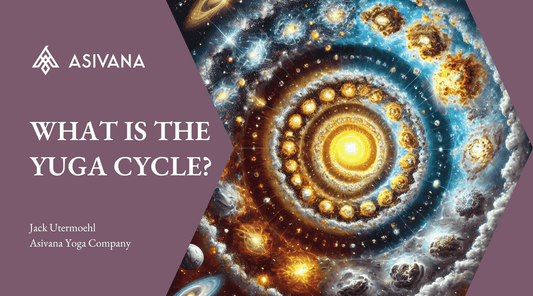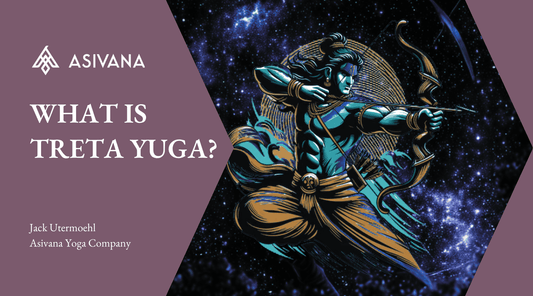
What is the Yuga Cycle? Chaturyuga (The Four Ages)
Jack UtermoehlShare
In the vast cosmology of Hindu thought, time does not march forward in a straight line. It spirals, turning like a wheel, forever revolving through creation, preservation, and dissolution.
Understanding the Word “Yuga”
Yuga (युग): A Sanskrit term meaning “age” or “epoch.” It refers to a distinct period of time marked by particular moral, spiritual, and societal conditions.
Chaturyuga (चतुर्युग): “Four Yugas” which is sometimes referred to as a "Maha Yuga." A complete cycle of time consisting of four successive ages:
-
- Satya Yuga
- Treta Yuga
- Dvapara Yuga
- Kali Yuga
Circular Time vs Linear Time
Most Western models of time follow a linear path: from beginning to end, from past to future, like a timeline marching toward progress or apocalypse. In contrast, Hindu cosmology envisions time as cyclical, eternal, and self-renewing.
This cyclical view allows for decay and rebirth. As Dharma fades, it is not lost forever. It returns, purified, when the cycle resets just as the full moon wanes only to wax again.
The Spiral of Consciousness: Sri Yukteswar’s Interpretation
In his book The Holy Science, Swami Sri Yukteswar introduced a revised understanding of the Yuga Cycle. Rather than one long downward slope, he proposed a 24,000-year cycle, sometimes referred to as a "Great Year", made of two arcs:
Descending Arc: Humanity moves away from spiritual truth into materialism and ignorance.
Ascending Arc: After reaching its lowest point, consciousness begins to rise again reclaiming higher consciousness.
In this model, the Yugas are not just ancient epochs, but repeating waves of spiritual evolution and decline mirrored in both cosmic time and our personal inner lives.
What is Chaturyuga? The Four Yugas at a Glance
Chaturyuga (Sanskrit: चतुर्युग) is the term for a complete cycle of four cosmic ages. Each age representing a gradual decline in spiritual purity, human virtue, and connection to Dharma (cosmic order).
These ages unfold in a precise order and repeat endlessly, like the turning of cosmic seasons. Here are the four Yugas that comprise a Chaturyuga:
Satya Yuga: The Age of Truth - pure Dharma, unity, and spiritual perfection.
Treta Yuga: The Age of Ritual - emergence of ego, rise of sacrifice, steady decline in virtue.
Dvapara Yuga: The Age of Duality - increasing materialism, divided dharma, outer worship prevails.
Kali Yuga: The Age of Darkness - spiritual ignorance, conflict, decline in ethics and lifespan.
Quick Comparison of the Four Yugas
| Yuga | Dharma Standing | Duration (Earth Years) | Key Traits | Spiritual Practice |
|---|---|---|---|---|
| Satya Yuga | 4 Legs (100%) | 1,728,000 | Truth, purity, non-violence, unity | Meditation (Dhyāna) |
| Treta Yuga | 3 Legs (75%) | 1,296,000 | Rise of ego, ritual, kingship, virtue in decline | Yajña (sacrificial fire) |
| Dvapara Yuga | 2 Legs (50%) | 864,000 | Duality, war, outer worship, technological rise | Temple worship, rituals |
| Kali Yuga | 1 Leg (25%) | 432,000 | Conflict, deceit, materialism, spiritual ignorance | Chanting (Hari Nāma) |
The Larger Cosmic Cycle
One full Chaturyuga spans 4.32 million years. According to the Vishnu Purana and other texts, 1000 Chaturyugas make up one day of Brahma, the Creator God in Hindu cosmology. That’s 4.32 billion human years per day of Brahma and an equal number for each night.
Time, in this framework, is unimaginably vast, repeating itself over eons. But each cycle contains essential truths for personal and collective evolution, no matter the age in which we live.
The Yuga Cycle by Duration
In Hindu cosmology, the duration of the Yuga Cycle is traditionally measured in vast spans of time. While most Puranic texts agree on one model, modern sages like Sri Yukteswar proposed a revised version based on a different understanding of cosmic cycles. Below is a side-by-side comparison.
Puranic vs. Yukteswar Yuga Durations
| Yuga | Core Duration | Transition Periods (Sandhyās) | Total Duration |
|---|---|---|---|
| Satya Yuga | 1,440,000 | 144,000 + 144,000 | 1,728,000 |
| Treta Yuga | 1,080,000 | 108,000 + 108,000 | 1,296,000 |
| Dvapara Yuga | 720,000 | 72,000 + 72,000 | 864,000 |
| Kali Yuga | 360,000 | 36,000 + 36,000 | 432,000 |
| Total (Maha Yuga) | 4,320,000 Years | ||
| Yuga | Duration (Descending) | Duration (Ascending) | Total |
|---|---|---|---|
| Satya Yuga | 1,200 | 1,200 | 2,400 |
| Treta Yuga | 900 | 900 | 1,800 |
| Dvapara Yuga | 600 | 600 | 1,200 |
| Kali Yuga | 300 | 300 | 600 |
| Total (Full Yuga Cycle) | 12,000 Years | ||
In Sri Yukteswar's model, these 12,000 years represent half of a full Yuga Cycle, accounting only for the Descending or Ascending arc. A complete Maha Yuga (or Chaturyuga) spans 24,000 years, cycling from spiritual heights to darkness and back again.
Symbolism and Decline of Dharma
One of the most powerful metaphors in Hindu cosmology is the image of the Dharma bull. This bull, symbolizing Dharma (cosmic order), stands steadily on four legs in Satya Yuga, representing the full presence of virtue in the world. With each passing Yuga, one leg of the bull is lost, reflecting a steady decline in moral and spiritual integrity.

As the ages progress, Dharma weakens and the nature of human life shifts accordingly:
| Yuga | Dharma (Legs of Bull) | Human Lifespan | Core Traits |
|---|---|---|---|
| Satya Yuga | 4 Legs | Up to 100,000 years | Truth, harmony, inner wisdom, purity |
| Treta Yuga | 3 Legs | Up to 10,000 years | Rituals, devotion, order, sacred law |
| Dvapara Yuga | 2 Legs | Up to 1,000 years | Duality, complexity, external worship |
| Kali Yuga | 1 Leg | 100 years or less | Conflict, ego, illusion, spiritual forgetfulness |
This gradual decline suggests not just a loss of morality, but also a shift in how humans interact with truth, knowledge, and the sacred. From intuitive union with spirit in Satya Yuga to chaotic disconnection in Kali Yuga, the Yuga Cycle maps the descent of consciousness across time.
Avatars of Vishnu Across the Yugas
To restore Dharma and rebalance the world, the deity Vishnu is said to incarnate in each Yuga. These avatars (divine incarnations) take specific forms suited to the needs and consciousness of the age, serving as living embodiments of cosmic order.
Satya Yuga
Matsya (Fish)
Kurma (Tortoise)
Varaha (Boar)
Narasimha (Man-Lion)
Treta Yuga
Vāmana (Dwarf)
Parashurama (Warrior Sage)
Rama (Prince of Dharma)
Dvapara Yuga
Krishna (Divine Teacher)
Balarama (in some traditions)
Kali Yuga
Chaitanya Mahaprabhu (Devotional Incarnation)
Kalki (Future Warrior)
Why This Matters
Each avatar addresses the spiritual decline of their time:
- Satya: Establish cosmic foundations (Matsya to Narasimha)
- Treta: Uphold righteousness through dharma-based action (Rama)
- Dvapara: Teach inner devotion and reveal divine truth (Krishna)
- Kali: Inspire bhakti (Chaitanya) and ultimately reset the cycle (Kalki)
In this view, Vishnu's avatars are archetypal forces restoring balance within the Yuga Cycle. They remind humanity of its potential, even in times of spiritual collapse.
Spiritual Practices for Each Yuga
Each Yuga carries a distinct quality of human consciousness, and thus a unique spiritual method is prescribed for awakening and aligning with Dharma in that era.
These practices are not arbitrary, they match the psychological, moral, and energetic conditions of humanity at the time.
| Yuga | Recommended Path | Why It Fits |
|---|---|---|
| Satya Yuga | Dhyana (Meditation) | Humanity is naturally pure and focused; silence leads directly to liberation |
| Treta Yuga | Yajña (Fire Sacrifice) | Spiritual effort begins; rituals maintain harmony with the divine order |
| Dvapara Yuga | Temple Worship & Ritual | Faith becomes externalized; divine connection sustained through sacred places and icons |
| Kali Yuga | Nāma Sankīrtana (Chanting the Divine Name) | Mind is restless and fragmented; chanting anchors awareness and purifies consciousness |
Scriptural Reference
“In Satya Yuga, the Supreme is attained by meditation; in Treta, by sacrifice; in Dvapara, by temple worship; and in Kali Yuga, by chanting the names of the Lord.”
- Bhagavata Purana 12.3.52
For Modern Yogis
Even though we live in Kali Yuga, all four practices remain available. Meditation, ritual, and sacred space continue to support spiritual development. Yet, for most, chanting and devotional practices offer the most accessible and powerful path to transformation today.
Integrating mantra repetition, group chanting (kirtan), and sacred sound into daily practice helps bridge ancient wisdom with modern needs reviving Satya Yuga consciousness in the heart, even amidst Kali Yuga’s noise.
Modern Interpretations and Psychological Readings
While the traditional Puranic model views the Yugas as vast epochs measured in hundreds of thousands or millions of years, many modern teachers reinterpret the Yuga Cycle symbolically, psychologically, or through revised astronomical models. These contemporary perspectives seek to make the Yugas relevant to the spiritual seeker today.
Sri Yukteswar’s 24,000-Year Cycle
In The Holy Science, Sri Yukteswar proposes that the Yuga Cycle spans 24,000 years. 12,000 descending into darkness (materialism), and 12,000 ascending back into light (spiritual awareness). According to this model:
- Satya Yuga is the age of highest spiritual perception.
- Treta Yuga sees a decline but maintains divine intuition.
- Dvapara Yuga marks scientific and intellectual awakening.
- Kali Yuga reflects spiritual ignorance and material obsession.
This model places us currently in the ascending phase of Dvapara Yuga, suggesting that human consciousness is gradually rising after the low point of Kali Yuga, which Yukteswar believed ended in 1700 CE.
Paramahansa Yogananda
Yogananda, a disciple of Yukteswar, integrated this view into his Kriya Yoga teachings. He taught that although we may live in a materially advanced age, the return to spiritual values is possible through dedicated practice.
For Yogananda, the Yugas are also reflections of inner evolution. Each stage represents a potential state of awareness, one we can intentionally develop through meditation and self-realization, regardless of the external age.
Sadhguru and Archetypal Views
Sadhguru interprets the Yugas less as chronological history and more as energetic possibilities. In his view:
“The Yugas are not about time, but about the level of consciousness prevalent in society.”
He teaches that Satya Yuga can be invoked inwardly through intense inner work. Thus, rather than waiting for cosmic cycles to shift, we are invited to align ourselves with higher states of perception in the present.
Psychological and Symbolic Readings
Many scholars and mystics interpret the Yuga Cycle as a mythic map of the psyche. From this view:
- Satya Yuga = unity consciousness, truth, Self-realization
- Treta Yuga = emergence of individuality and discipline
- Dvapara Yuga = duality, complexity, search for balance
- Kali Yuga = fragmentation, egoism, disconnection
This symbolic lens allows yoga practitioners to see the Yugas as inner seasons of the soul guiding personal evolution through cycles of consciousness, loss, growth, and return.
Why the Yuga Cycle Matters for Yoga Practitioners
The Yuga Cycle is a mirror for the yogi’s path. Whether understood historically, symbolically, or psychologically, it offers a powerful framework for grounded spiritual discipline in turbulent times.
Navigating the Challenges of Kali Yuga
We live in an age of distraction, division, and spiritual forgetfulness. According to traditional teachings, Kali Yuga is the most difficult time for inner work and also the most potent.
In this age, even a little practice yields immense results because of the intensity of opposition.
- Choose clarity over noise
- Maintain simplicity in a world of excess
- Commit to ethical action and inner integrity
- Chant the Divine Name (Nama Sankirtana) as the most accessible practice
Reclaiming Satya Yuga Consciousness
Though we are not in the Golden Age, the yogic path allows us to live as if we were. Every time we meditate, choose truth, or act with compassion, we invite the presence of Satya Yuga into our moment-to-moment experience.
In this sense, the Yugas live inside us. We pass through them many times in a single life, awakening, forgetting, returning. Yoga gives us the tools to witness this cycle and stabilize in the higher states that were once humanity’s baseline.
Reflection Prompts
- Which Yuga best describes your current inner experience?
- What practices help you remember your highest nature?
- How can you serve as a vessel of Dharma in this age?
Conclusion
Time in yogic tradition is not linear, it is cyclical, spiraling through descent and ascent, darkness and light. The Yuga Cycle reminds us that all things change, return, and evolve.
For the modern practitioner, this understanding is an invitation to embody patience, consciousness, and faith. Instead of despairing the age we live in, we remember that even in the densest times, the potential for Satya Yuga remains within.
To know the Yugas is to see the bigger picture of spiritual evolution. It helps us honor our place in the wheel to act with humility, courage, and remembrance of the light that precedes and follows us.










